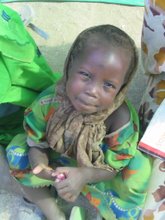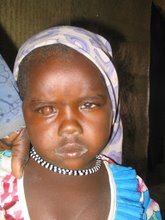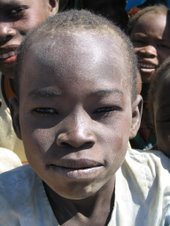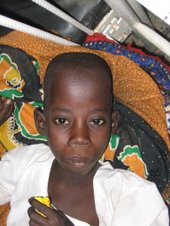Thursday, November 20, 2008
One Person's Vision
Dear Friends,
In June 2007, I began a 40-day train trip around the country to speak about Darfur and ask activists, students and people of faith about an idea for a new one-year campaign called Tents of Hope. The response was overwhelming. People wanted to order tents even before the campaign was launched. When I returned to California in August, a small group of us from the United Church of Christ (UCC) and the Christian Church (Disciples of Christ) created a plan for Tents of Hope. We launched the campaign in September 2007.
Would the campaign take off? I wasn’t sure. The idea for Tents of Hope germinated in the spring after I had many discussions with Darfur activists about low morale in the Darfur Movement. We had been working to end the genocide for over three years and the situation in Darfur was getting more hopeless by the day. I spoke about my concerns with Elly Simmons, a brilliant Marin artist with a long history of social activism. We thought the idea of painting tents would work because it could bring communities together in a creative and fun way. But the task of organizing Tents of Hope was daunting. We had no office, no staff and no money. We only had an idea.
After the campaign was launched, we began reaching out to Darfur advocacy organizations, religious denominations and interfaith organizations, Sudanese groups and human rights organizations. We asked them to help us spread the word about Tents of Hope. The UCC and Disciples provided seed money that allowed us to hire a few staff workers. In the fall and winter of 2007, the campaign grew very slowly. After four months, less than 50 cities had joined the campaign. People who were involved agreed that it was a good idea, but not enough people were learning about the campaign. We were running out of money quickly. One day my phone and Internet service were turned off because I couldn’t pay the bill. I was very discouraged and wondered if we should give up.
Then something remarkable happened. In January 2008, we began to receive calls from dozens of small towns across the country. Youth directors at churches and synagogues and teachers at K-12 schools wanted to use the tents as a way to teach young people about the world and social responsibility. Artists saw it as a way to join creativity and compassion together. Painting a tent is fun. But it also connects us to the people of Darfur as we reflect on their suffering and hopes while painting the tents. Over the next few months, the number of cities participating in Tents of Hope doubled and tripled. By May 2008, over 300 cities had joined the campaign. (The final number is close to 400 cities in 48 states and 8 countries.) In most cities, an assortment of schools, congregations and civic groups participated in painting the tents while learning about and advocating for Darfur and raising funds for humanitarian relief.
Intense planning for the “Gathering of the Tents” began in May. New people, some volunteers and some paid, came aboard to perform critical jobs. Our budget expanded thanks to help from campaign partners and generous donors. We all worked very hard. Our core team slowly took shape, and as we learned to work together, lifelong friendships began to form. Many of us were raising children at the same time that we were working on the campaign. On numerous conference calls, babies could be heard crying in the background and children could be heard asking for help with their homework (including my 9-year-old son, Jonathan). I guess that’s the difference between a campaign and an organization. In a campaign, every day is take-your-children-to-work day!
The “Gathering of the Tents” at the National Mall in Washington DC and the “Interfaith Weekend of Prayer and Action for Sudan” on November 7-9 were incredibly successful. You can see from the photos on the website that local communities are an endless source of creativity, compassion and hope. Almost 400 tents were on the National Mall! The tents are beautiful works of art and a powerful message of our solidarity with the people of Darfur.
It’s very sad for me to see the Tents of Hope campaign come to an end. For the last 16 months, I have been blessed to be part of the most inspiring work of my life. The stories and photographs that poured into our email boxes kept us continually amazed and encouraged to work even harder. But the end of the campaign allows us time to reflect on our experiences and accomplishments. We did it! In the coming weeks, we will post your stories, photos and media coverage on the website. I encourage everyone to continue this creative dialogue of hope and compassion as we work together for an end to the genocide in Darfur.
The campaign still faces some challenging financial hurdles. We will be sending hundreds of tents to Darfur through the Darfur Peace and Development Organization. We need your financial help to ship the tents to Darfur. We also have many expenses that still need to be paid. Please consider making a donation online at www.tentsofhope.org. Small donations are welcomed just as much as large ones because Tents of Hope has always been about people everywhere pitching in to help.
We met our goal for Tents of Hope, and all of us can feel a sense of accomplishment. As a writer, I appreciate a story that has a beginning, middle and end. When I finish a book I try to understand the way that I have been changed by reading the book. How have I been changed by Tents of Hope? How have you?
My understanding of the Darfur Movement has been radically transformed. I used to think that hope would arise from a change of policy toward Sudan by the international community. In other words, I thought that hope for ending the genocide in Darfur rested in the hands of governments. It doesn’t. You are the hope. It may take many years for peace and justice to come to Sudan. At times, we may get discouraged and want to give up. The only thing that will keep us going in this movement to end genocide in Darfur is the strength that we get from one another. We are a community of compassion. Compassion is a powerful force for change. It allows us to see that we all belong to one human family and that we have a responsibility to one another. When you look at the images and messages on the tents, you will see this consciousness of global solidarity in every color and every language.
Thank you from the bottom of my heart for your decision to act on your compassion and desire for peace and justice in Sudan by participating in the Tents of Hope campaign. This campaign was only one expression of the Darfur Movement. But if the creativity and beauty that we see on the surfaces of the tents is any indication of the creativity and beauty in all of your hearts, I am more than confident that our struggle against genocide in Darfur will succeed. Remember, you are the hope.
With gratitude and joy,
Tim Nonn
National Coordinator
Tents of Hope
In June 2007, I began a 40-day train trip around the country to speak about Darfur and ask activists, students and people of faith about an idea for a new one-year campaign called Tents of Hope. The response was overwhelming. People wanted to order tents even before the campaign was launched. When I returned to California in August, a small group of us from the United Church of Christ (UCC) and the Christian Church (Disciples of Christ) created a plan for Tents of Hope. We launched the campaign in September 2007.
Would the campaign take off? I wasn’t sure. The idea for Tents of Hope germinated in the spring after I had many discussions with Darfur activists about low morale in the Darfur Movement. We had been working to end the genocide for over three years and the situation in Darfur was getting more hopeless by the day. I spoke about my concerns with Elly Simmons, a brilliant Marin artist with a long history of social activism. We thought the idea of painting tents would work because it could bring communities together in a creative and fun way. But the task of organizing Tents of Hope was daunting. We had no office, no staff and no money. We only had an idea.
After the campaign was launched, we began reaching out to Darfur advocacy organizations, religious denominations and interfaith organizations, Sudanese groups and human rights organizations. We asked them to help us spread the word about Tents of Hope. The UCC and Disciples provided seed money that allowed us to hire a few staff workers. In the fall and winter of 2007, the campaign grew very slowly. After four months, less than 50 cities had joined the campaign. People who were involved agreed that it was a good idea, but not enough people were learning about the campaign. We were running out of money quickly. One day my phone and Internet service were turned off because I couldn’t pay the bill. I was very discouraged and wondered if we should give up.
Then something remarkable happened. In January 2008, we began to receive calls from dozens of small towns across the country. Youth directors at churches and synagogues and teachers at K-12 schools wanted to use the tents as a way to teach young people about the world and social responsibility. Artists saw it as a way to join creativity and compassion together. Painting a tent is fun. But it also connects us to the people of Darfur as we reflect on their suffering and hopes while painting the tents. Over the next few months, the number of cities participating in Tents of Hope doubled and tripled. By May 2008, over 300 cities had joined the campaign. (The final number is close to 400 cities in 48 states and 8 countries.) In most cities, an assortment of schools, congregations and civic groups participated in painting the tents while learning about and advocating for Darfur and raising funds for humanitarian relief.
Intense planning for the “Gathering of the Tents” began in May. New people, some volunteers and some paid, came aboard to perform critical jobs. Our budget expanded thanks to help from campaign partners and generous donors. We all worked very hard. Our core team slowly took shape, and as we learned to work together, lifelong friendships began to form. Many of us were raising children at the same time that we were working on the campaign. On numerous conference calls, babies could be heard crying in the background and children could be heard asking for help with their homework (including my 9-year-old son, Jonathan). I guess that’s the difference between a campaign and an organization. In a campaign, every day is take-your-children-to-work day!
The “Gathering of the Tents” at the National Mall in Washington DC and the “Interfaith Weekend of Prayer and Action for Sudan” on November 7-9 were incredibly successful. You can see from the photos on the website that local communities are an endless source of creativity, compassion and hope. Almost 400 tents were on the National Mall! The tents are beautiful works of art and a powerful message of our solidarity with the people of Darfur.
It’s very sad for me to see the Tents of Hope campaign come to an end. For the last 16 months, I have been blessed to be part of the most inspiring work of my life. The stories and photographs that poured into our email boxes kept us continually amazed and encouraged to work even harder. But the end of the campaign allows us time to reflect on our experiences and accomplishments. We did it! In the coming weeks, we will post your stories, photos and media coverage on the website. I encourage everyone to continue this creative dialogue of hope and compassion as we work together for an end to the genocide in Darfur.
The campaign still faces some challenging financial hurdles. We will be sending hundreds of tents to Darfur through the Darfur Peace and Development Organization. We need your financial help to ship the tents to Darfur. We also have many expenses that still need to be paid. Please consider making a donation online at www.tentsofhope.org. Small donations are welcomed just as much as large ones because Tents of Hope has always been about people everywhere pitching in to help.
We met our goal for Tents of Hope, and all of us can feel a sense of accomplishment. As a writer, I appreciate a story that has a beginning, middle and end. When I finish a book I try to understand the way that I have been changed by reading the book. How have I been changed by Tents of Hope? How have you?
My understanding of the Darfur Movement has been radically transformed. I used to think that hope would arise from a change of policy toward Sudan by the international community. In other words, I thought that hope for ending the genocide in Darfur rested in the hands of governments. It doesn’t. You are the hope. It may take many years for peace and justice to come to Sudan. At times, we may get discouraged and want to give up. The only thing that will keep us going in this movement to end genocide in Darfur is the strength that we get from one another. We are a community of compassion. Compassion is a powerful force for change. It allows us to see that we all belong to one human family and that we have a responsibility to one another. When you look at the images and messages on the tents, you will see this consciousness of global solidarity in every color and every language.
Thank you from the bottom of my heart for your decision to act on your compassion and desire for peace and justice in Sudan by participating in the Tents of Hope campaign. This campaign was only one expression of the Darfur Movement. But if the creativity and beauty that we see on the surfaces of the tents is any indication of the creativity and beauty in all of your hearts, I am more than confident that our struggle against genocide in Darfur will succeed. Remember, you are the hope.
With gratitude and joy,
Tim Nonn
National Coordinator
Tents of Hope








